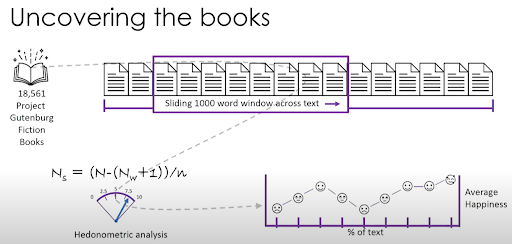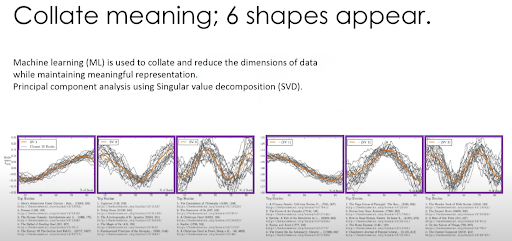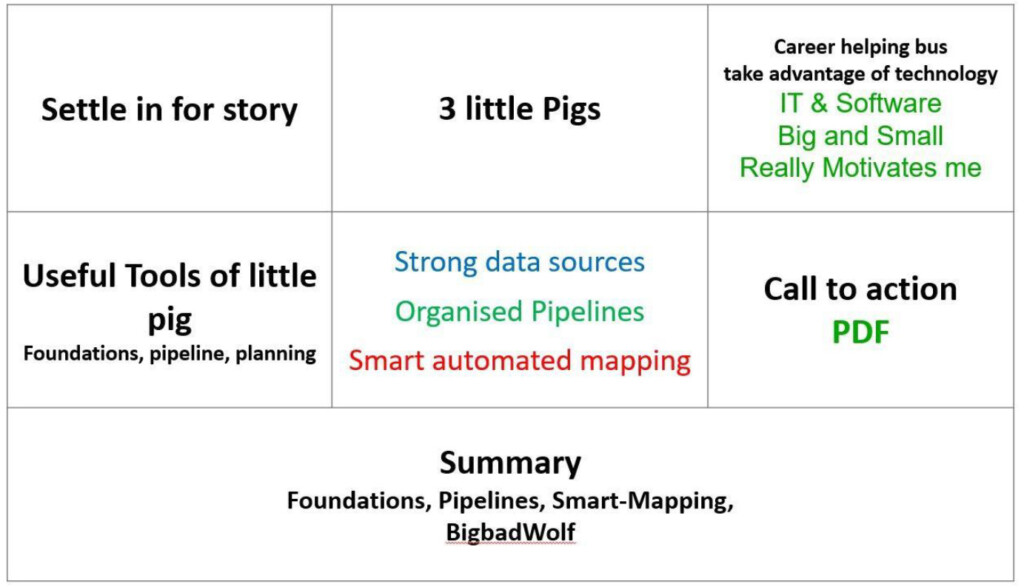Once upon a time in a meeting room far far away, I told the story of 3 little pigs to a bunch of unsuspecting people.
Not your usual business presentation that’s for sure – but it was carefully calculated to make sure the message was received by the audience loud and clear, even if they didn’t realize it. Still to this day I ask my colleagues about the 3 little pigs and they can remember the advantages of data and analytics platforms over spreadsheets…
Of course, you can’t just go round telling children’s stories, but for millennia, stories have been crafted round story arcs designed to draw the listener in, to great effect. You can use these story arcs when discussing your project or business.
Step 1. Storytime
So how can stories be so effective? Enter The University of Vermont’s Computational Story Laboratory (CSL). They took 51,250 Project Guttenberg books, filtered to just the 18,561 fiction books, processed the text through various deep-learning, hedonometric analytic techniques looking at the sentiment of each word, sentence and paragraph, and plotting them on a narrative time graph.

What they found were 6 distinct correlations indicating 6 different emotional arcs:
- Rags to Riches (rise)
- Tragedy (fall)
- Man in a hole (fall-rise)
- Icarus (rise-fall)
- Cinderella (rise-fall-rise)
- Oedipus (fall-rise-fall)

Icarus rose out of prison with wings his father helped him build from feathers and wax. But even after his fathers advice not to fly too close to the sun lest the wax should melt and he would fall, he still did and ended up crashing into the sea. Do NOT finish your presentation here. It’s clear by now, you mustn’t end your story in a fall just like Icarus. The Icarus story arc:

The most important story arc for us to use in any presentation is No.5 – Cinderella (rise-fall-rise)
We’re introduced to our leading character, the beautiful Cinderella, who starts off sad and washing floors then through magic goes to the ball. Soon, our beloved’s story takes a turn for the worse when the ‘baddie’ of the midnight bells tolls and sends her home early. The tension of time (an ever important aspect of a suspenseful story) and multiple glass slipper tryouts adds to the audiences wishes for release, brought only by our handsome hero, the Prince, finding the foot which fits the slipper, and they live happily ever after!

Step 2. How to apply this to your business
So how can you use this in your presentations to have your call to action happily ever after?
Imagine you’re describing how adopting new warehouse automation software could help a business in the busy rush before Christmas. Rise and Fall would be trying hard and ultimately failing. So let’s apply Cinderella’s story-time arc to your story instead.
Here, we have people to root for, a baddie, lots of tension and YOU can be the hero. Make sure your call to action leads towards a positive step and you’ll have created a happily ever after!

You’ll see the same pattern in the well-known 3 little pigs story, which I used for the presentation below, videoed by a colleague. I also presented this on stage in front of over 100 people at TINTech London, with the same lights off, fireplace style too!
Here, I deployed many other techniques as well, like being in the middle of the room, the fireplace, humor, props/limbic items, eye contact, pauses, extra tension, lights off, relaxed nature and, most importantly, key business benefits of data and analytic platforms over spreadsheets – this is after all, a business tool not just story-time!

The 3 little data and analytics pigs by Mark Green
“Once upon a time there were three little pigs and the time came for them to leave home and seek their fortunes. Before they left, their mother told them “Whatever you do, do it the best that you can because that’s the way to get along in the world.”
The first little pig built his financial reporting using guesswork because it was the easiest thing to do. The second little pig built his house out of spreadsheets. This was a little bit stronger than the guesswork house. The third little pig built his house using data warehouse and analytics software.
One night, the big bad wolf of wall street, who as CFO of Storytime Corp dearly loved to eat little accounting piggies, came along and saw the first little pig in his house of guesswork. He said, “Let me in, Let me in, little pig or I’ll huff and I’ll puff and I’ll find out your predictive analysis of our quarterly sales results are nothing but a finger in the air!”
“Not by the hair of my chinny chin chin”, said the little pig. But of course, the wolf did blow the house in and ate the first little pig.
The wolf then came to the house of spreadsheets. “Let me in, Let me in little pig or I’ll huff and I’ll puff and bring down this feeble structure of over complicated formulas and documents which no-one can remember how they were created and hopefully they won’t break as we can’t fix them!”
“Not by the hair of my chinny chin chin”, said the little pig. But the wolf blew that house in too and ate the second little pig.
The wolf then came to the house of data warehouse and analytics software. “Let me in, let me in,” cried the wolf. “Or I’ll huff and I’ll puff till I pick apart your annual statements and easy to integrate data sources with super reliable smart connectors and real language report building!”
“Not by the hair of my chinny chin chin” said the pig. Well, the wolf huffed and puffed, but he could not blow down that brick house.
But the wolf was old and sly, it wasn’t his first time trying to destroy best-practice software architecture and data planning, so he climbed up on the roof to look for a way into the third house.
The little pig saw the wolf climb up on the roof and lit a roaring fire in the fireplace and placed on it a large kettle of water.
When the wolf finally found the hole in the chimney he crawled down and KERSPLASH right into that kettle of water. That was the end of his troubles with the big bad wolf.
The next day the little pig invited his mother over. She said “You see it is just as I told you. The way to get along in the world is to not use guesswork, not use outdated methods of financial reporting, but take the opportunity to do something great with your company, its data, and its future.” Fortunately for that little pig, he learned that lesson. And he just lived happily ever after!”

My presentation is wrapped by a meaningful structure with the story just being one part of it. That structure is something I’ll discuss more another time, but there’s a sneak peak of my lectern sheet in the table above.
Step 3. Profit (don’t forget why you’re there)
Stories are great, they have for thousands of years been the primary method of capturing people’s imagination and passing on good ideas to the people listening. But you should always tie it back to the purpose of your presentation and lead people to an ultimate conclusion – one that because your audience is so engaged, they’ll remember forever.
We’ve seen how children’s stories do it, but believe me, it’s exactly the same when you watch a movie. Intro to characters, things go well, there’s some drama, something happens to save the day, and everything is all happy in the end (unless it’s an incredibly boring, scary or depressing movie!).
Applying these lessons to your conversations will become second nature if you see the power of bringing people onboard with your idea but framing them as the hero.
For Buyer Enablement, we already have a champion, so that’s easily sorted. We can tell of how at Company X we helped the champion overcome adversity of endless presales demos or huge targets to reach with little chance of success. These are the heroes and challenges we work with every day, so it’s your job to weave a creative and engaging story to help others see that they too, can be the hero.
Presales Demand Gap
Presales is too busy doing overview demos to deliver anything else.

Presales Activity Gap
Presales has no time to meet the needs of buyers during other parts of their learning journey.

Sales Time to Respond
Length of time a buyer has to wait for a demo is really long and they lose interest.

Which story do you tell?
